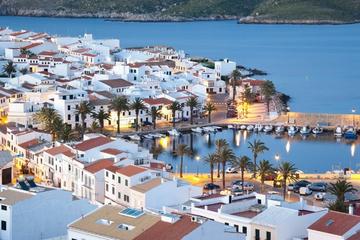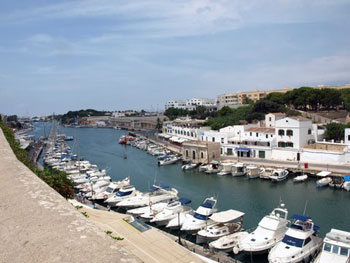
by Jean Knill
The ports of Menorca sit almost opposite each other, one on the east coast, and the other on the west, of the northernmost of the three Spanish Balearic Islands. The 28-mile main road that links the ports of Mahon (or Mao as the locals call it) and Ciutadella divides the wilder, craggy north from the calmer, flatter lands to the south. The shape made by the island’s road map has been likened to a fish-bone, with many smaller roads linking this backbone road to the villages and coastal resorts on either side.
The port in the west, and nearest to mainland Spain, is Ciutadella, once the island’s capital city and still its religious centre. At its heart, built high above the inlet that forms its port, is the old town, a labyrinth of ancient streets, squares and narrow alleyways.
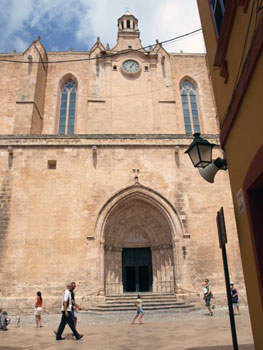 The 14th century Cathay Gothic cathedral in the Plaza de Pio XII, and its surrounding area, miraculously escaped destruction in 1558 when Barbarossa, the pirate Red Beard, attacked and destroyed the town with his Turkish mercenaries. The cathedral’s ornate Baroque style Chapel of the Souls was added in the 17th century, when much of the town was finally rebuilt. Then in the 19th century, it was finished with a neo-classical front facade. It still also contains a small minaret from the mosque that occupied its space before it was turned into a cathedral on the orders of King Alfonso III of Aragón, who took the island from its ruling Moors in 1287.
The 14th century Cathay Gothic cathedral in the Plaza de Pio XII, and its surrounding area, miraculously escaped destruction in 1558 when Barbarossa, the pirate Red Beard, attacked and destroyed the town with his Turkish mercenaries. The cathedral’s ornate Baroque style Chapel of the Souls was added in the 17th century, when much of the town was finally rebuilt. Then in the 19th century, it was finished with a neo-classical front facade. It still also contains a small minaret from the mosque that occupied its space before it was turned into a cathedral on the orders of King Alfonso III of Aragón, who took the island from its ruling Moors in 1287.
Menorca’s violent history includes occupations by Phoenicians, Greeks, Romans, Vandals, Moors, British and French. Many of these influences are present in its architecture. We easily recognized Arabic detail in the arches of the covered walkway along Ses Voltes, a popular alleyway running between the cathedral square and the Plaça Nova on the edge of the old town.
Walking from the cathedral in the opposite direction, we came to Placa des Born, a large square with wide roads surrounding a raised central area often covered in market stalls, and finished with an obelisk at its centre. This was raised to commemorate the Menorcans who lost their lives or were forcibly removed and enslaved at the time of the pirate attack.
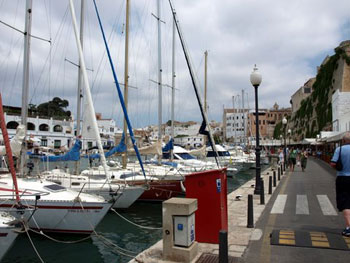 The square is edged with grand palaces on the cathedral side opposite the imposing Town Hall and theatre. Next to the theatre is a magnificent viewpoint looking out over the harbour. A couple of pavement cafes sit beyond this next to the corner that leads to the steps down to the harbour, which is lined on this side with popular restaurants.
The square is edged with grand palaces on the cathedral side opposite the imposing Town Hall and theatre. Next to the theatre is a magnificent viewpoint looking out over the harbour. A couple of pavement cafes sit beyond this next to the corner that leads to the steps down to the harbour, which is lined on this side with popular restaurants.
Ciutadella really comes into its own on the 23rd and 24th of June each year as it celebrates the festival of St John. Known as the most important fiesta of Menorca, it kicks off the fiesta season on this party island. Every little town or village seems to have one when it is the turn of their own particular patron saint. The fiestas also seem to be a celebration of the locally bred Menorquin horses, which are always a central feature. Beautifully turned out black stallions join the festivities, rearing up and ‘dancing’ on their hind legs encouraged by the crowds of spectators.
In 1708 the British came to Menorca, attracted by Mahon’s natural harbour, the longest and deepest in the Mediterranean. Apart from a short time when they were ousted by the French, they were to rule the island for a hundred years, finally relinquishing it back to the Spanish early in the 19th century.
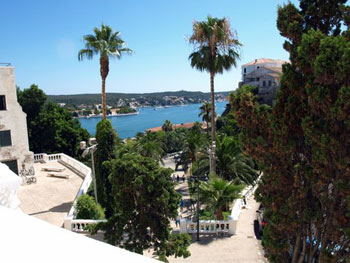 The natural advantages of the waters of Mahon meant that the British based themselves there and declared it the new capital of the island. But the clerics of the time refused to move, so Ciutadella retains its cathedral and its religious superiority.
The natural advantages of the waters of Mahon meant that the British based themselves there and declared it the new capital of the island. But the clerics of the time refused to move, so Ciutadella retains its cathedral and its religious superiority.
And while Ciutadella has its medieval heart, we found that Mahon sports some wonderful Georgian architecture, legacy of the British occupation. Many of the old religious buildings have been given new and different leases of life. The indoor market is housed in a former convent, as is The Museum of Menorca in the Placa des Monastir.
As in Ciutadella, the town sits above the port and we found some wonderful viewpoints, or miradors, as they are known in Spanish. On leaving the museum, we turned left to check out one of these before heading along the Calle Isabel II. The houses on the left all have an unobstructed view of the port. One of them was the British governor’s residence, and is now the headquarters of the island’s military governor. The terraced homes on the other side of the street sport beautifully decorative ironwork on their balconies.
 Unlike Ciutadella, Mahon town occupies only the southern side of the port. The opposite side houses the naval base. It is also where new resorts are being developed alongside some wonderful villas that include one where Admiral Nelson and Emma Hamilton are said to have had some romantic trysts.
Unlike Ciutadella, Mahon town occupies only the southern side of the port. The opposite side houses the naval base. It is also where new resorts are being developed alongside some wonderful villas that include one where Admiral Nelson and Emma Hamilton are said to have had some romantic trysts.
All this can be seen from the water, if having descended the grand central steps to the harbourside, you take one of the boat trips along the 3 mile harbour. You might also see up to three cruise ships docked in this haven from the wilder weather and waters of the open sea. The entrance is guarded by forts on either side. On the northern shore is the great Spanish fort of La Mola, which took a good half-day for us to appreciate its size and more fantastic viewpoints. To the south is the British built Fort Marlborough, a much more subtle building on higher ground.
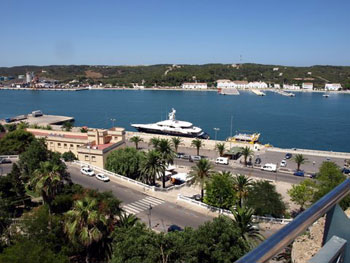 Back on the harbour side of Mahon, if it’s time for a tipple, you can head for the centuries old Xoriguer Gin Distillery, famous for supplying unique Menorcan gin to Admiral Nelson’s British sailors. Or there are plenty of good bars and restaurants on the landward side of the harbour road, or up in the town above.
Back on the harbour side of Mahon, if it’s time for a tipple, you can head for the centuries old Xoriguer Gin Distillery, famous for supplying unique Menorcan gin to Admiral Nelson’s British sailors. Or there are plenty of good bars and restaurants on the landward side of the harbour road, or up in the town above.
Just as the northern and southern parts of Menorca have very different characteristics, so have the ports in the east and the west. But both are soaked in history with much to offer, and are well worth visiting.
If You Go:
If you want to spend time wandering around these ports, it’s best to avoid visiting Menorca in July and August when it can get really hot, although the island’s beaches will always be perfect for sun seekers.
Most people stay at the dozen or so resorts outside the ports and make day trips to see them. Of the resorts, the prettiest is Cala Galdana in the south west.
To get to Menorca, you fly to Mahon airport, which is only a few kilometres from the city.
There is a good bus service between Mahon and Ciutadella. All the bus services run from Mahon, so to get anywhere else on the island by public transport, you may need to go there first.
Menorca is known as an open air museum. There are historical sites dotted about all over the island.
www.aboutmenorca.com is a good place to get further information.
About the author:
Jean Knill began her career as a freelance writer in the early 1980s. Her work has been published in many UK magazines and newspapers – including SHE, The Lady, My Weekly, Sports Industries, and Church Times – as well as in writing and travel e-zines. Until recently, her writing has been slotted in beside teaching and marketing projects. Now she has retired from these sidelines and is rejoicing in the freedom to write as much as she wants.
All photos are by Jean Knill.
